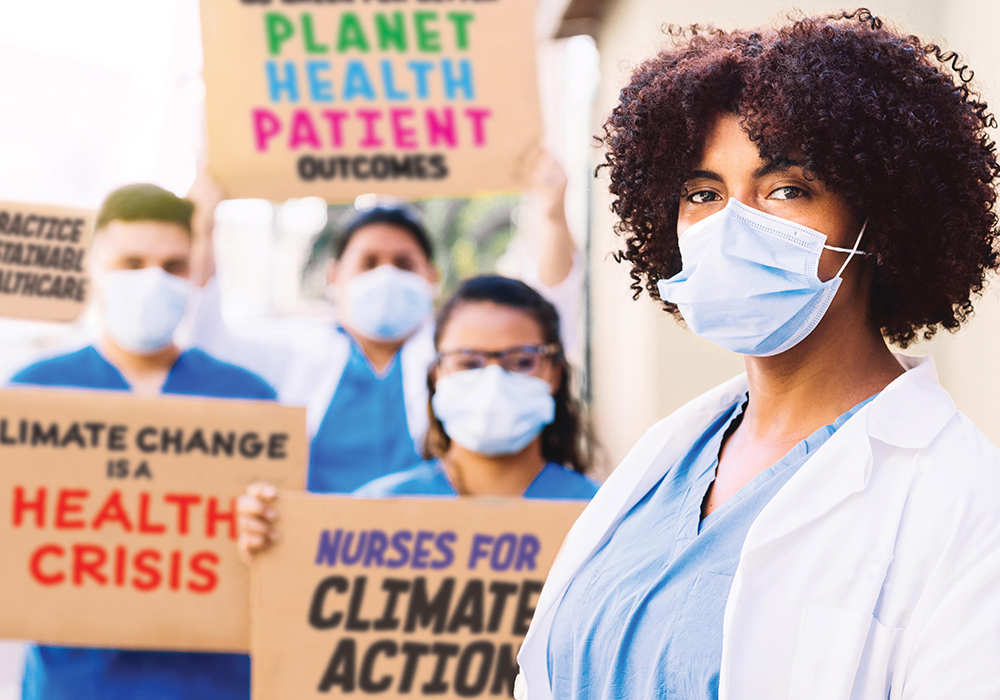Climate change affects more than weather patterns or the environment; it also has a substantial impact on human health. Its contribution to the cancer burden includes increased levels of carcinogens, comorbidity factors, cancer incidence, and cancer mortality and reduced access to care.
In a report published in the February 2022 issue of the Clinical Journal of Oncology Nursing, Dickman et al. outlined climate change’s implications for patients with cancer and cancer care and challenged oncology nurses to take action through specific strategies.
Cancer, the Climate, and Health Care
Global warming from greenhouse gas emissions has led to rising sea levels, catastrophic weather events, droughts, heat waves, wildfires, and flooding—all of which contributed to increased levels of carcinogens like air pollution, ultraviolet (UV) rays, and environmental toxins. Other downstream effects include reduced access to food, water, and care and increased vector-carried infectious diseases.
Health care is the second largest contributor to global warming after the transportation industry, Dickman et al. said. Pharmaceutical production, massive energy use, medical and food waste, and gasses used for surgical anesthesia produce substantial greenhouse gas emissions. And cancer itself is a factor as well: as the cancer population grows, so too does its usage of a high-waste system.
Studies have shown that global warming is implicated for:
- 4.7% of lung cancer deaths (from toxins in airborne particulate matter)
- 76% of melanoma diagnoses (from increased UV radiation)
- Polluted food and water systems (from manufacturing and environmental toxins)
- Water-, food-, and vector-borne infectious diseases (from fleas, ticks, and mosquitoes)
- Heat-related deaths in older adults, patients with cancer, and other vulnerable populations
Oncology Nursing’s Responsibility to the Climate
“The RN practices in a manner that advances environmental safety and health,” the American Nurses Association said in its 2021 Scope and Standards of Practice. Dickman et al. identified three specific areas for oncology nurses to meet that standard.
Environmental stewardship: On a personal level, nurses can reduce their own environmental footprint through actions like:
- Use cleaner transportation options or simply walk or cycle.
- Reduce energy use and use cleaner power (e.g., wind, solar).
- Eat a more plant-based diet.
- Use environmentally friendly and reusable household products.
- Reduce waste by repurposing and recycling.
And remember that your impact is compounded: although the steps seem small for one nurse, the effect is enormous when the United States’ four million nurses all take part.
Education and advocacy: The public identifies lack of awareness as its biggest barrier to engaging in environmental stewardship, Dickman et al. reported. Oncology nurses are expert educators and advocates, and they can use those skills to communicate the climate change message.
Studies show that risk communication that describes the evidence about the environment’s link to health outcomes facilitates shared decision-making, Dickman et al. said. They outlined how oncology nurses can use that strategy in their education and advocacy.
- Present the evidence in a meaningful, logical, and actionable conversation.
- Build rapport with the patient and understand their environment and community, then tailor the message to their lifestyle.
- Discuss how patients can reduce their environment-related risk.
- Offer ideas for lowering their own environmental footprint.
Dickman et al. also cited the need for advocacy at the policymaking level. They recommended that oncology nurses contact their local, state, and federal legislators and use risk communication and storytelling in their conversations. Learn more about contacting your policymakers with ONS Voice.
Sustainable healthcare practices: At an institutional level, Dickman et al. said that oncology nurses can advocate for developing or better adhering to practices such as:
- Reduce waste by repurposing items and returning unopened supplies to inventory.
- Recycle, compost, and decrease reliance on single-use plastic.
- Offer more environmentally sustainable and plant-based food service choices.
- Seek clean energy sources.
- Create green teams that include multiple disciplines to identify sustainability opportunities.
For more information about oncology nursing’s role in health-related climate change, read the full article by Dickman et al.
ONS Perspective
A patient’s environment is a social determinant of health, a factor that the National Academy of Medicine charged nurses to address in its Future of Nursing 2020–2030 report. To that end, ONS is partnering with a group of ONS members to develop advocacy and other strategies to effect change. Join the Climate Change and Patient Care Focus Group, and learn more about the work on the Oncology Nursing Podcast Episode 190: The Environment, Cancer, and Nurses’ Role in Advocating for Climate Change.






